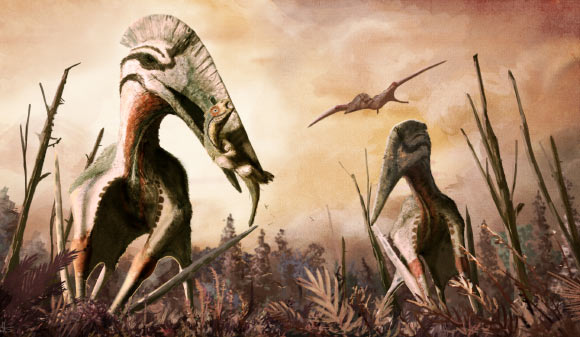Hatzegopteryx, a flying reptile with a 10-m wingspan and a mass of 220 kg, was the dominant predator in what is now Romania between 72-66 million years ago, according to a study by paleontologists in the UK.

Hatzegopteryx, depicted here as a short-necked, powerful predator, consumes the dwarf dinosaur Zalmoxes in Late Cretaceous Romania. Image credit: Mark Witton, University of Portsmouth.
Dr. Mark Witton from the University of Portsmouth and Dr. Darren Naish from University of Southampton examined the recently discovered neck vertebra of Hatzegopteryx.
They believe the ancient creature was a formidable carnivore and major predator that terrorized dinosaurs and other prehistoric animals of the Late Cretaceous Romania.
Hatzegopteryx is a member of Azhdarchidae, a group of long-necked, long-jawed pterosaurs.
However, the researchers suggest Hatzegopteryx had a considerably shorter and stronger neck, and with larger muscle masses.
Other remains of Hatzegopteryx include a jaw joint indicative of a 50-cm wide skull and reinforced limb bones.
“The proportions and structural reinforcement of all these elements are unlike those of any other azhdarchid species and would have made Hatzegopteryx a powerful and dominant predator,” Dr. Witton said.
“The difference in structural properties between giant azhdarchid neck bones is remarkable — they’re in different biomechanical leagues, with Hatzegopteryx many times stronger than anything else on record.”
“This, along with our calculations of neck length and muscle mass, suggests giant azhdarchids may have been radically different in appearance and behavior.”
“The large, reinforced skeleton and muscle power would have made it a formidable predator of other animals when stalking ancient prairies and woodlands.”
“It may have even been capable of attacking animals too large or vigorous for other flying reptiles, even the other giants.”
Hatzegopteryx lived in a peculiar island ecosystem where many of the dinosaurs were dwarfed or belonged to relict lineages extinct in the rest of the Cretaceous world.
“Ancient Transylvania was a strange place for a number of reasons, including the fact that we’ve yet to find evidence of large predatory animals that lived alongside Hatzegopteryx, such as giant carnivorous dinosaurs. This is despite centuries of sampling,” Dr. Witton said.
This work thus potentially provides an answer to a mystery about life in Late Cretaceous Romania.
“Perhaps without large predators to challenge them, this island provided an opportunity for giant pterosaurs — already formidable animals — to become the dominant predators,” Dr. Witton said.
“The finer details of ecology and lifestyle for Hatzegopteryx remain unknown because we’re still working from scraps of its skeleton, but the emerging picture of its lifestyle are fascinating.”
“In some respects our unexpected findings highlight how little we actually know about these animals.”
“We’ve had these scrappy remains for years, but we need to ask the right questions, and perform the right tests, to realize their significance.”
“Future giant pterosaur research and discoveries almost certainly have many more surprises for us.”
The study was published online Jan. 18, 2017 in the journal PeerJ.
_____
D. Naish & M.P. Witton. 2017. Neck biomechanics indicate that giant Transylvanian azhdarchid pterosaurs were short-necked arch predators. PeerJ 5: e2908; doi: 10.7717/peerj.2908







